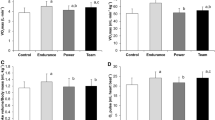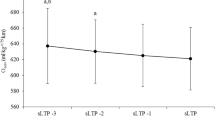Summary
The physiology of marathon running has been extensively studied both in the laboratory and in the field, but these investigations have been confined to elite competitors. In the present study 28 competitors who took part in a marathon race (42.2 km) have been studied; 18 male subjects recorded times from 2 h 19 min 58 s to 4 h 53 min 23 s; 10 female subjects recorded times between 2 h 53 min 4 s and 5 h 16 min 1 s. Subjects visited the laboratory 2–3 weeks after the race and ran on a motor driven treadmill at a series of speeds and inclines; oxygen uptake \(\dot V\)O2 was measured during running at average marathon racing pace. Maximum oxygen uptake (\(\dot V\)O2 max) was measured during uphill running. For both males (r=0.88) and females (r=0.63), linear relationships were found to exist between marathon performance and aerobic capacity. Similarly, the fraction of \(\dot V\)O2 max which was sustained throughout the race was significantly correlated with performance for both male (r=0.74) and female (r=0.73) runners.
The fastest runners were running at a speed requiring approximately 75% of \(\dot V\)O2 max; for the slowest runners, the work load corresponded to approximately 60% of \(\dot V\)O2 max.
Correction of these estimates for the additional effort involved in overcoming air resistance, and in running on uneven terrain will substantially increase the oxygen requirement for the faster runners, while having a much smaller effect on the work rate of the slowest competitors. Five minutes of treadmill running at average racing pace at zero gradient did not result in marked elevation of the blood lactate concentration in any of the subjects.
Similar content being viewed by others
References
åstrand PO, Rodahl K (1977) Textbook of work physiology, 2nd edn. Academic Press, New York
Connor LR, Morrell AJH (1972) Statistics in theory and practice, 6th edn. Pitman Publishing, London
Costill DL, Fox EL (1969) Energetics of marathon running. Med Sci Sports 1: 81–86
Costill DL, Winrow E (1970) Maximal oxygen intake among marathon runners. Arch Phys Med 51: 317–320
Costill DL, Bowers R, Kammer WF (1970) Skinfold estimates of body fat among marathon runners. Med Sci Sports 2: 93–95
Costill DL, Branam G, Eddy D, Sparks K (1971) Determinants of marathon running success. Int Z Angew Physiol 29: 249–254
Costill DL, Thomason H, Roberts E (1973) Fractional utilisation of the aerobic capacity during distance running. Med Sci Sports 5: 248–252
Davies CTM, Thompson MW (1979) Aerobic performance of female marathon and male ultramarathon athletes. Eur J Appl Physiol 41: 233–245
Dill DB (1965) Marathoner DeMar: Physiological studies. J Natl Cancer Inst 35: 185–191
Durnin JVGA, Ramahan MM (1967) The assessment of the amount of fat in the human body from measurements of skinfold thickness. Br J Nutr 21: 681–689
Hagan RD, Strathman T, Strathman L, Geltman LR (1980) Oxygen uptake and energy expenditure during horizontal treadmill running. J Appl Physiol: Respirat Environ Exercise Physiol 49: 571–575
Jakeman P, Davies B (1979) The characteristics of a low resistance breathing valve designed for the measurement of high aerobic capacity. Br J Sports Med 13: 81–83
Maron MB, Horvath SM, Wilkerson JE, Gliner JA (1976) Oxygen uptake measurements during competive marathon running. J Appl Physiol 40: 836–838
Maughan RJ (1982) A simple, rapid method for the determination of glucose, lactate, pyruvate, alanine, 3-OH butyrate and acetoacetate in a single 20 Μl blood sample. Clin Chim Acta 122: 231–240
Pugh LGCE (1970) Oxygen intake in track and treadmill running with observations on the effect of air resistance. J Physiol 207: 823–835
Saltin B, Karlsson J (1971) Muscle ATP, CP and lactate during exercise after physical conditioning. In: Pernow B, Saltin B (eds) Muscle metabolism during exercise. Plenum, New York, pp 395–399
Shephard RJ (1969) A nomogram to calculate the oxygen cost of running at slow speeds. J Sports Med Phys Fitness 9: 10–16
Wilmore JH, Brown CH (1974) Physiological profiles of women distance runners. Med Sci Sports 6: 178–181
Author information
Authors and Affiliations
Rights and permissions
About this article
Cite this article
Maughan, R.J., Leiper, J.B. Aerobic capacity and fractional utilisation of aerobic capacity in elite and non-elite male and female marathon runners. Europ. J. Appl. Physiol. 52, 80–87 (1983). https://doi.org/10.1007/BF00429030
Accepted:
Issue Date:
DOI: https://doi.org/10.1007/BF00429030




